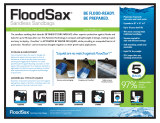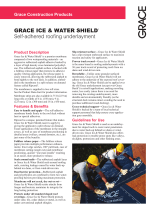Page is loading ...

FLOOD BAGS
& BARRIERS
Frequently
Asked Questions
Quick Dams, what are they and how do they work?
Quick Dams contain a super absorbent polymer
(similar to what’s inside baby diapers) that react
and swell on contact with water. Once activated
(typically 5 minutes), the water is contained as a gel
within the fabric, thus acting as a barrier.
How do you activate them?
Lay them in position and wait for the rain, spray
with a hose, dunk them in a bucket of water, lay
them in a puddle or place them in a fresh water
source like a stream.
Do I have to add water?
Depending on your situation, you may pre-activate
them or let the weather activate them. Quick Dams
can be placed in position and wait for water to
arrive. If a current of water is expected, partially
activating them is recommended so that they don’t
oat away. If building a retaining wall is desired, pre-
soaking & stacking them is recommended.
Do Quick Dams or any other water activated
sandbags work with salt water applications?
No, Quick Dams do not work with salt water,
calcium, lime or chlorine. There is a chemical
reaction that causes the absorbed water to be
released back out, making them not effective as a
barrier & must be thrown away.
How should I position Quick Dam Flood Barriers?
Flood Barriers contain a wedge to prevent them
from rolling. When laying in position, be sure to
place the “mini channel” away from ooding water.
This will assure that as it grows, it acts as a wedge
to secure in position. Ideally, place Quick Dams
outdoors in the path of problem water & divert
it, before it becomes a problem. They can also be
used to absorb & contain a leak or spill.
Can these be used for Oil & Chemicals?
Quick Dams should be pre-activated with water to
create a barrier & then they can be used to control
other uids. They will not activate without the
presence of water.
I noticed some white crystals on the outside of the
product after I activated it. Is that normal?
Yes, this is normal. During our manufacturing
process the needles can pull the powder through
the stitched seam, which will cause crystals to
appear the rst time you activate the product.
The gelled water will wash away with water, degrade
over time & is non toxic & nonhazardous.
How long do Quick Dams last?
Un-activated: indenite as long as kept dry,
so store in their closed package until needed.
Activated: if left in position, they can last for
6-12 months.
Can I re-use them?
Yes, you can re-use them. Once activated, Quick
Dams will remain active until the water evaporates,
typically taking several weeks for complete
evaporation. If left in position, they will shrink while
evaporating and grow when re-exposed to water.
They seem to shrink. Is that normal?
Yes, as the water evaporates, they will get smaller.
If complete evaporation is desired, store Quick
Dams in a dry environment , like a garage or shed.
Over several weeks, Quick Dams will shrink &
become crunchy & ready to store away. Once re-
exposed to water, they will absorb & swell again.
What do I do with them when I’m done?
Quick Dams are environmentally friendly and can
be disposed of in the trash. Polymer contents will
degrade with UV exposure, pressure and time,
leaving an empty pouch that can be thrown in
the trash. Gelled contents can be cut out of bag &
spread on lawn or garden to provide temporary
moisture until degradation occurs, typically within
a few days. Contents will be VERY slippery, so keep
off of walkways to prevent slip & fall accidents.
THE NEXT GENERATION IN FLOOD PROTECTION
TM

I notice a slimy feel on the Quick Dams, what is that?
Quick Dams contain a super absorbent polymer
that is non-toxic & non-hazardous and will degrade
over time. This degradation is the slime that you feel.
Simply wash or wipe it off.
Can Quick Dams be used indoors and outdoors?
Yes they can, although they will be moist, so be
careful when leaving them on oors that are
susceptible to water damage.
What stops Quick Dams from rolling away?
Quick Dam Flood Barriers have an extra wedge
stitched along its length that acts as a wedge &
prevents them from rolling away.
Can they protect against water higher than 3.5in?
Quick Dams can be stacked 3 high in a brick
formation. If you need to go higher, widen the base
like a pyramid formation. The higher you need
the wall height, the thicker the base should be.
Stacking straight up will create an unstable base
and they may slide off.
Will Quick Dams leak water?
Quick Dams will absorb, swell & gel water, creating
a barrier. If the surface is uneven, seepage may
occur. If large amounts of water are expected,
double layers or stacking & building a wall may be
necessary to prevent leakage. Quick Dams are not
a solution for every application.
Will Quick Dams get moldy?
Quick Dams alone will not grow mold, but if they are
activated with contaminated water, then there is a
possibility, so storing them outdoors to dry out
is recommended.
Do Quick Dams have an odor?
No, not on their own. Although they will absorb an
odor if it is present in the uid absorbed, and this
may cause it to split open.
Can I drive over Quick Dam Flood Barriers?
Yes & No. As long as the Barriers are NOT fully
activated, then you can drive over it- making sure to
"squish" the gel back in place to prevent water from
seeping through in that area. If the Barriers are fully
activated, then you cannot, as the gel needs to
go somewhere.
How long do they take to dry out to store away?
Time will vary based on weather conditions. The
hotter, drier areas will take a month or so, & more
humid, cooler areas may take 3 months. They will
be left crunchy. During drying- do NOT leave them
in the sun, as this causes them to degrade & not
reactivate later.
Will Quick Dams oat?
Until they are activated- they can oat on the water-
so pre-activating & stacking them may be necessary.
Quick Dams should always be stacked higher than
the water to avoid oatation.
Can Quick Dams be used in the winter/snow?
Will they freeze?
Yes, they can be used in the winter/snow. Make sure
they are fully activated before freezing temperatures
occur to assure maximum protection when the snow
is melting. We do not recommend moving them while
frozen to prevent any tearing of the outer material.
Also, Salt on the roads should not come in contact
with Quick Dams. To help, pre-activate Quick Dams
with water & then wrap plastic under & over the top
to prevent the salt from making contact.
I’ve seen other similar items using a white
knit or jute fabric, how are they different from
Quick Dams?
One of the key features of Quick Dams (Patent
Pending) is the black non-woven durable fabric that
provides UV protection that prevents degradation of
the inner absorbent. Allowing the consumer to leave
Quick Dams in position, for many months of ongoing
protection. The white, knit & jute products allow UV
rays to penetrate through to the inner absorbent,
thus degrading them in only 2-3 weeks.
Can Quick Dams be used in the garage for snow
melt protection?
Yes they can, but if the cars or driveway have salt
on them, this may cause the Quick Dams to only
partially absorb & still allow moisture underneath.
For this application, we recommend wrapping them
in plastic after activation or the Water Curb or
Water-Gate.
Why is there seepage underneath Quick Dams?
Uneven surfaces may be the cause as well as when
Quick Dams are used on pourous surfaces (un
nished concrete)- both sides are ghting to absorb
water- so there can be some seepage around them.
I let Quick Dams dry out, but notice a white lm left
behind on the ground- what is this?
We are unsure of the exact nature, but we believe
it is due to metals, calcium or contaminants in the
water that was absorbed. We suggest lime scale
remover as a possible solution.
/





